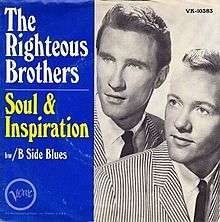(You're My) Soul and Inspiration
"(You're My) Soul and Inspiration" is a song by American pop duo the Righteous Brothers. It was the group's first hit after leaving their long-time producer Phil Spector. The song was written by Barry Mann and Cynthia Weil, who also wrote the group's first hit "You've Lost That Lovin' Feelin'" along with Phil Spector. It is the title track of their album.[1] The single peaked at No. 1 on the US Billboard Hot 100, and reached No. 15 on the UK Singles Chart. Billboard ranked the record as the No. 3 single for 1966.[2]
| "(You're My) Soul and Inspiration" | ||||
|---|---|---|---|---|
 | ||||
| Single by The Righteous Brothers | ||||
| from the album Soul and Inspiration | ||||
| B-side | "B-Side Blues" | |||
| Released | February 26, 1966 | |||
| Recorded | late 1965 | |||
| Genre | Pop, rock and roll, blue-eyed soul | |||
| Length | 3:00 | |||
| Label | Verve | |||
| Songwriter(s) | Barry Mann, Cynthia Weil | |||
| Producer(s) | Bill Medley | |||
| The Righteous Brothers singles chronology | ||||
| ||||
Background
The song was written by Barry Mann and Cynthia Weil, part of the legendary Brill Building pop machine in New York City.[3] They first began writing it following the success of the Righteous Brothers' first single with Phil Spector, "You've Lost That Lovin' Feelin'", which they also wrote. However, the song was not completed as they thought it sounded too much like "Lovin' Feelin",[4] and Spector chose instead to record Carole King and Gerry Goffin's "Just Once in My Life" as the duo's second single.[5]
After leaving Spector's Philles Records in late 1965, the Righteous Brothers moved to the mostly jazz-oriented Verve label. Bill Medley of the Righteous Brothers then asked Mann about the incomplete "Soul and Inspiration" that the songwriters had played for Medley when they first started writing it, and asked them to complete the song. Mann and Weil complied with the wishes of Medley, and the Righteous Brothers then recorded in late 1965 the finished song.[4][6]
The song was arranged by Jack Nitzsche who had arranged many of Phil Spector's records,[7] and Medley produced the song in style not different from the sound of the group's early hits with Spector. Medley was able to imitate Spector's "Wall of Sound" technique with reverbing pop-orchestration and soaring female back-up choir. Some of the session musicians from the Wrecking Crew, such as the keyboard players Don Randi, pianist Michel Rubini and bassist Jimmy Bond, were hired for the recording.[7] Other musicians on this record included Art Munson on guitar, Michael Patterson on piano, Drew Johnson on drums, Bill Baker (who also arranged the song) on sax, Dick Shearer on trombone, and Bill King, Sanford Skinner and Bob Faust on trumpets.[8] It used a string section as well and there is a spoken section by Bobby Hatfield in the bridge.
The song was released on February 26, 1966,[9] and reached No. 1 on the Billboard Hot 100, and stayed at the top for three weeks.[10] This was, however, the end of the group's peak in popularity. Although they entered the charts with their next single, the religiously-oriented "He" (No. 18 US), before briefly splitting in 1968, they did not enter the top-10 again until reuniting in 1974 with "Rock and Roll Heaven", an ode to deceased musicians.[1]
Cover versions
In 1969, the vocal group the Blossoms covered the tune with Righteous Brothers member Bill Medley producing.
In 1972, the reggae artist Paddy Corea covered the tune instrumentally for the UK label Trojan Records. The song is available on the 1995 cover-compilation Keep on Running.[11]
In 1973, Doc Severinsen recorded an instrumental version of this song on his Trumpets & Crumpets & Things album.
In 1978, Donny and Marie Osmond went to No. 38 on the Billboard Hot 100 with their mild pop version.
In 1990, the country music group the Oak Ridge Boys recorded a cover version for the soundtrack of the film My Heroes Have Always Been Cowboys. This version peaked at #31 on the Billboard Hot Country Singles & Tracks charts.[12]
Bill Medley himself covered the song in 1994 as a duet with fellow Phil Spector client Darlene Love.
Charts and certifications
Weekly charts
|
Certifications
| |||||||||||||||||
References
- Richmond, Peter. "Righteous Brothers Discography". Archived from the original on 13 September 2007. Retrieved 11 September 2007.
- "1966". billboard Top 100.
- Kurutz, Steve. "Biography of Cynthia Weil". Retrieved 17 September 2007.
- Mike Ragogna (July 9, 2012). "Soul & Inspiration: A Conversation With Songwriters Barry Mann & Cynthia Weil, Plus Milan's Calibro 35". Huffington Post.
- Bill Medley (April 24, 2014). The Time of My Life: A Righteous Brother's Memoir. Da Capo Press. p. 34. ISBN 978-0306823169.
- Unterberger, Richie. "Biography of The Righteous Brothers". Retrieved 18 September 2007.
- Don Randi; Karen "Nish" Nishimura (August 1, 2015). You've Heard These Hands: From the Wall of Sound to the Wrecking Crew and Other Incredible Stories. Hal Leonard. ISBN 978-1495008825.
- "Record Details". 45cat.
- Richard Williams (November 17, 2009). Phil Spector: Out Of His Head (Revised ed.). Omnibus Press. ISBN 9780857120564.
- Mark Ribowsky (2 May 2000). He's a Rebel: Phil Spector--Rock and Roll's Legendary Producer. Cooper Square Press. pp. 213. ISBN 9781461661030.
- Farley, Keith. "All Music Guide: Keep on Running". Retrieved 18 December 2009.
- Whitburn, Joel (2008). Hot Country Songs 1944 to 2008. Record Research, Inc. p. 303. ISBN 0-89820-177-2.
- "Top RPM Singles: Issue 5721." RPM. Library and Archives Canada.
- "Righteous Brothers: Artist Chart History". Official Charts Company.
- "The Righteous Brothers Chart History (Hot 100)". Billboard.
- "American single certifications – Righteous Brothers – Righteous Brothers". Recording Industry Association of America. If necessary, click Advanced, then click Format, then select Single, then click SEARCH.